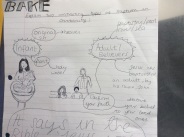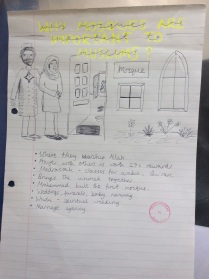This is the third and final post on how I would describe my teaching as ‘knowledge rich’. The previous posts in the series can be accessed below.
- Planning schemes using knowledge
- Direct instruction with focus on context and linking of contexts
- Direct instruction & note taking
- Testing
- Foundation knowledge & depth of knowledge
- Use of etymology & focus on keywords
This post will focus on what I do in my classroom to ensure that students are learning the content that I teach them. Learning in this context means to me that in a day or a week or a month and beyond, they can recall correct information.
Direct Instruction
If we are clear on what it is that we want students to know and understand we then have a decision to make on how they get to know it.
My definition of direct instruction here, is just me explaining to them some of the important knowledge or skills. It’s usually me talking, using a pen and whiteboard and sometimes using a powerpoint slide particularly with things like quotations from holy texts or important pictures, that are easier to prepare in advance.

I use images and diagrams to help explain where appropriate. I use the whiteboard as the visual representation of the concept or ideas I’m trying to teach. Anyone walking in and seeing this will probably think it’s a mess but it’s a representation of layers of explanation. It shows a process of explanation not an image of one thing. I include key words, definitions, visual representations of abstract concepts and useless drawings of important things (stick people are common).
But my belief is that this direct instruction isn’t a passive, inactive time for students. It’s the time when they get to think about things; process them. Almost as soon as I start to explain something a hand will go up with a question. That question leads to further explanations. Some questions spark a discussion in the class. Students are processing the information I’ve given them. This is a process that leads to understanding. They ask the questions that help clarify their thoughts. They engage with the content directly. Silently, in their heads, some will be processing what they think about it. I can ‘see’ them pondering the ‘what ifs’ and struggling with the ‘this is different to me’. They’re unusually silent when I’m explaining. They want more of the ‘stuff’. This is the part of the lesson where they make the links to prior learning. They are developing their schema of the topic and it’s exciting! They can suddenly make more connections and sometimes they audibly share these revelations. They feel clever as they would never have understood this part if they didn’t know the stuff from last lesson. Every episode of direct instruction helps build up a picture. The sharing of and processing of this knowledge is the foundation of everything else they will do.
“And here’s how you should think about memory: it’s the residue of thought, meaning that the more you think about something, the more likely it is that you’ll remember it later……You remember what you think about, but not every fleeting thought—only those matters to which you really devote some attention.”
Daniel Willingham https://www.aft.org/sites/default/files/periodicals/willingham_0.pdf
Context
One way in which I have developed what I teach in this part of the lesson is deliberately focusing on context. There is a danger when thinking about teaching knowledge that each lesson becomes a disconnected series of the important things they should know.
An RE example
For example, if teaching Judaism some people teach: one lesson on Jewish religious clothing, one lesson on Passover, one lesson on the synagogue, one lesson on the Torah etc I have done this in the past when I thought that students needed to know as much about a religion as possible in the time frame. I have now pulled back from this and spend this time looking at the context and core concepts that will allow students to understand things in much more depth. We spend a few lessons looking at Abraham and Moses and the importance of their relationship with God and the situations they were in. We look at why the commandments/mitzvot were a really important thing for them at the time and how the covenant was made. The context of this is very important in understanding Judaism and what Jews do today. If I’d just done lessons on random aspects of Judaism the depth of their knowledge and understanding would be limited as they wouldn’t have the foundations to fully understand the context of each thing within Jewish history.
This means that even though I don’t teach them about the synagogue, if they did their own reading they would understand much of what they read due to the important concepts they had already learnt.
Note taking
There is almost a set routine to this important part of the lesson where I am going to explain important things. Their books and pens are ready, everyone is looking to the board and there is complete silence.
To emphasise the importance they are told to take notes after I’ve explained each part.
This starts in Year 7. Students have to do a mixture of compulsory note taking and then independent note taking. For example I may write a date or definition on the board and they should copy this. However unless I say they have to, they can opt to take additional notes. I leave this up to them.
I show students good and bad examples of note taking from the start. I make suggestions of how they present their work. I want to encourage independence and pride in their work. Some are more creative than others.
I will often start the next lesson telling them to open their books on their notes and specifically ask questions that I know they have the answer to in their books. This means I can ask anybody in the room the same question and expect an answer. I will give them time to look in their notes. This emphasises to them the importance of these notes; they will need them. It also promotes a sense of ‘learning’; ‘we already know this’. It reminds them of the important foundational knowledge we’ve already covered that will be built on in this next lesson.
Testing
I have blogged many times on how I do this. It is such a big part of my teaching, lessons and homework.
- Start of lesson 1-10 quiz
- Keyword/quote tests
- Mixed topic tests
- Homework quizzes
In relation to the focus of this blog, these are the strategies I use to help them to remember the important knowledge we’ve learnt in class. If they don’t remember the things I’ve explained then what was the point of the lesson? Too often, teachers soldier on to the ‘next lesson’ in their scheme to move forward and forget the important part of helping students to remember each step along the way. These tests are my way of helping students to remember. All a teacher needs to do is ask themselves these questions at the end of each lesson: When will students use/recall this knowledge again? How will I help them to do this? If the answer is ‘never’, you might as well have not taught that lesson.
Knowledge isn’t everything….
..but it’s more important than I used to think.
These three posts have explained how I have developed my practice to promote the importance of knowledge. They’re snapshots of the aspects of my teaching that I believe put knowledge at the centre. It’s not everything I do. Learning is much more complex than just knowledge. However I can see the significant difference this emphasis on knowledge had made to student understanding when they have the vocabulary and understanding to be able to ask well-informed questions and discuss things they would never have had the foundations to ask before.



